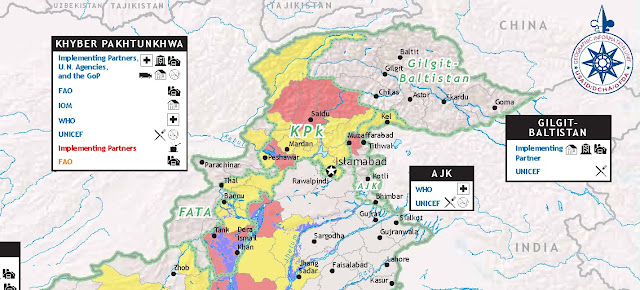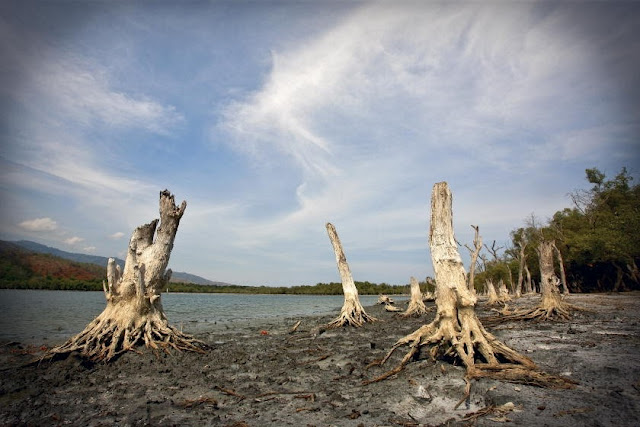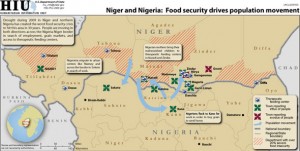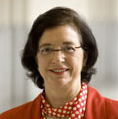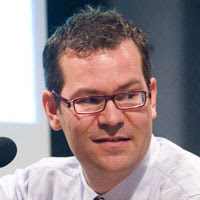Showing posts from category natural resources.
-
Watch: Joel E. Cohen on Solving the Resource-Population Equation in the Developing World
›December 14, 2010 // By Wilson Center Staff“It’s very hard to put a number on a quantity that depends on future events, processes we don’t understand, and values that may change over time,” said Joel E. Cohenof the Rockefeller University in this interview with ECSP. “That doesn’t mean we have no problems and it doesn’t mean there’s nothing we can do.”
There are three schools of thought or proposed “panaceas,” when it comes to balancing natural resources and population, said Cohen: a bigger pie (new technology to increase productivity), fewer forks (reduced consumption), and better manners (reduced irrational market inequities and better governance).
In the 15 years since his book How Many People Can the Earth Support? was published, Cohen’s approach has changed. While the 1996 book lacked a definitive policy recommendation, he is now analyzing options. “The evolution of my thought has moved from ‘how many people can the Earth support?’ to ‘what do we need to solve problems?’” he said.
You need adequate child and maternal nutrition to produce potential problem solvers and you need education to give them the tools to do it with, said Cohen, who studied the impact of universal primary and secondary education with colleagues at the American Academy of Arts and Sciences.
“If you look at a map of stunting in the world, there are parts of South Asia and sub-Saharan Africa where more than half the children are stunted – that means two standard deviations [of] height below normal for their age,” said Cohen. “Those populations are handicapped at the starting gate because they don’t have the problem solvers.” -
International Responses to Pakistan’s Water Crisis
›December 6, 2010 // By Michael KugelmanExcerpt from the executive summary of the NOREF Policy Brief, via the Norwegian Peacebuilding Centre:
Pakistan faces a multidimensional water crisis that claims hundreds of thousands of lives every year. The root causes of the crisis are twofold:- Circumstantial, which are linked to poor water-resource management policies (including water-wasting flood irrigation);
- Structural, tied to factors deeply ingrained in politics and society such as the obsession with India, inequitable rural land-ownership and endemic water misgovernance (for example, exploitation of the rotational irrigation system to the detriment of the poor).
However, international responses must be measured. They should actively target the circumstantial causes but, at the same time, recognize that their ability to take on the structural ones is limited. While the international community can help mitigate the effects of the underlying structural drivers, Pakistan itself must take the ultimate steps to eliminate them.
Circumstantial causes can be addressed through international aid provision and international exchanges. Aid provision must be generous enough to meet Pakistan’s prodigious needs but modest enough to respect the country’s limited absorptive capacities. It should emphasize the restoration of infrastructure and distribution systems, be more responsive to the needs of Sindh and Baluchistan provinces, and be channeled through both government agencies and civil society.
Despite the challenges the international community faces in addressing the structural causes, opportunities do abound. These include embarking on back-channel diplomacy to bring Pakistan and India closer together and cooperative projects with Pakistanis to make water distribution more equitable. To be effective, international responses must target all affected parties and be sensitive to ground realities. They should also be mindful of indigenous success stories and the factors that bring about that success.
The full report, “International Responses to Pakistan’s Water Crisis: Opportunities and Challenges,” is available through the Norwegian Peacebuilding Centre.
Michael Kugelman is program associate with the Asia Program at the Woodrow Wilson International Center for Scholars.
Image Credit: Adapted from “USG Humanitarian Assistance to Pakistan for Floods in FY 2010 and FY 2011 (as of 30 Nov 2010),” courtesy of USAID and ReliefWeb. -
Joydeep Gupta, ChinaDialogue
Nervous Neighbors: China-India Water Relations
›December 3, 2010 // By Wilson Center StaffExcerpted from the original article, “Nervous Neighbors,” on ChinaDialogue.net:
Only five rivers in the world carry more water than the Yarlung Zangbo, or Brahmaputra, as it is known when it reaches India. Only one carries more silt. Rising at a height of 5,300 meters in the Kailash range of the Middle Himalayas – an area holy to both Hindus and Buddhists – the river flows east through Tibet for 1,625 kilometers before taking a horseshoe bend, changing its name and flowing as the Brahmaputra into north-eastern India.
There, for 918 kilometers, it is both a lifeline, due to the water it carries, and a scourge, because of the floods it causes almost every year. It then takes a southward turn and flows into Bangladesh for 363 kilometers before it merges with the Ganges, together forming South Asia’s largest river, the Meghna, and flowing into the Bay of Bengal. This huge river, with its 25 large tributaries in Tibet and 105 in India, drains much of the eastern Himalayas.
As the world’s youngest mountain range, the Himalayas are particularly unstable – and so is the river. It has changed its course significantly at least once in the last 200 years, following a major earthquake. Smaller changes in course are common, wiping out farms and homes on one bank while depositing fertile silt on the other. Now humans are changing the course of this river: Chinese engineers have started to build the Zangmu hydroelectric power station in Lhoka prefecture, 325 kilometers from Lhasa, Tibet’s capital. The development has led to serious expressions of concern, particularly in India but also in China.
Continue reading on ChinaDialogue.net.
Joydeep Gupta is the project director (South Asia) of ChinaDialogue’s Third Pole Project.
Map Credit: Google Maps. -
Climate-Proofing Development: An Interview With Karen Hardee
›November 29, 2010 // By Hannah Marqusee
While expectations are deflated for broad international consensus at the UN Climate Change Convention in Cancun, the need to “climate-proof” development efforts has been gaining ground in recent years as a necessary preventative measure to help developing countries adapt to the adverse effects of climate change.
-
Watch: Blue Ventures PHE Program in Madagascar
›“All conservation efforts will be in vain if family planning issues aren’t addressed,” says Rebecca Hill, project manager for the Sexual and Reproductive Health Programme at Blue Ventures in a video highlighting their population, health, and environment (PHE) programming in Madagascar.
While primarily a marine conservation group, Blue Ventures also recognizes the need for integrating population into their efforts. They began a family planning program in southwestern Madagascar in 2008 as part of a “holistic approach to conservation.” The project aims to address the high unmet need for family planning, high fertility and maternal and infant mortality, and conserve the coastal environment. “We are directly saving lives,” Hill says.
Rapid population growth is creating an unsustainable strain on natural resources, as Matthew Erdman of Blue Ventures wrote in a previous post on The New Security Beat:The average total fertility rate in Velondriake is 6.7 children per woman, according to our data. On average women are only 15 years old when they first conceive. To compound this problem, a majority of the population is under the age of 15 – at or approaching reproductive age. At the current growth rate, the local population will double in only 10 to 15 years. The local food sources, already heavily depleted, barely feed the current population, let alone twice that amount. Without enabling these coastal communities to stabilize their population growth, efforts to improve the state of marine resources and the community’s food security are considerably hindered.
Hill describes the situation in the village when she joined the Blue Ventures in 2008 as “alarming,” with women “having up to 17 children despite not wanting children.” Many people in the town had never heard of condoms and had no idea how to use them, she said, and “they are desperate to have access to contraception.”
Today, the initial family planning program has been scaled up to the surrounding region and generated significant community involvement by peer educators teaching community members about sexual and reproductive health. It’s also become the first PHE project to receive support from the UNFPA within Madagascar.
There are currently 18 community-based distributors who give out two types of contraception in their villages. The fact that the community has so fully embraced the project shows that it can be replicated elsewhere, says Hill in the video. “Communities themselves have harnessed the ideas and consider that what we’re doing is vitally important.”
“Addressing family planning needs and issues is inextricably linked with conservation issues,” says Hill. “All conservation efforts will be in vain, if family planning issues are not addressed.”
Video Credit: Blue Ventures Family Planning Project from Alexander Goodman on Vimeo. -
Nigeria’s Future Clouded by Oil, Climate Change, and Scarcity [Part Two, The Sahel]
›November 19, 2010 // By Schuyler NullIf southern Nigeria’s demographic and environmental problems have helped fuel today’s conflicts, it’s the north’s issues that may feed the conflicts of tomorrow.
Nigeria’s lack of development and poor governance is not exclusive to the delta region, only more well-known because its oil reserves. The north of the country, which is predominately Muslim and accounts for more than half of Nigeria’s population, faces many of the same problems of environmental degradation, lack of jobs, and inadequate infrastructure. Northern Nigeria is also growing much faster than the south, with a total fertility rate of 6.6 children per woman, compared to 4.6 in the southern states. The median age of first-time mothers in northern Nigeria is only 18 years old.Nigeria holds nearly a fifth of the entire population of sub-Saharan Africa. By 2050, it’s expected to pass Indonesia, Brazil, and Bangladesh and take its place among the top five most populous countries in the world, according to UN estimates. But a litany of outstanding and new development, security, and environmental issues – both in the long-troubled Niger delta in the south and the newly inflamed north – present a real threat to one West Africa’s most critical countries.
If southern Nigeria’s demographic and environmental problems have helped fuel today’s conflicts, it’s the north’s issues that may feed the conflicts of tomorrow.
Nigeria’s lack of development and poor governance is not exclusive to the delta region, only more well-known because its oil reserves. The north of the country, which is predominately Muslim and accounts for more than half of Nigeria’s population, faces many of the same problems of environmental degradation, lack of jobs, and inadequate infrastructure. Northern Nigeria is also growing much faster than the south, with a total fertility rate of 6.6 children per woman, compared to 4.6 in the southern states. The median age of first-time mothers in northern Nigeria is only 18 years old.
Climate, Culture, and Discontent in the North
Last summer, in an offensive that stretched across four northern states, a hardline Islamist group called Boko Haram emerged suddenly to challenge the government, attacking police stations, barracks, and churches in escalating violence that claimed more than 700 lives, according to The Guardian. The government responded with a brutal crackdown, but recent targeted killings and a prison break seem to indicate the group is back.
Perhaps most distressingly, Boko Haram appears to have won some local support. Said one local cloth trader to The New York Times in an interview this October, “It’s the government’s fault. Our representatives and our government, they are not sincere. What one person acquires is enough to care for a massive amount of people.”
As in the south, mismanagement of natural resources has also played a role in creating a dangerous atmosphere of distrust in the government. After gold was discovered this spring in northwestern Nigeria, many under- and unemployed flocked to the region to try their luck, but they also unwittingly contaminated local water with high levels of lead. Although the state health officials say they have now identified more than 180 villages thought to be affected, the epidemic was only discovered after a French NGO stumbled upon it while testing for meningitis in June. More than 400 infant deaths have been connected to the mining, according to Reuters.
Contributing to natural resource-related misery in the north are climatic changes. Declining rainfall in the West African Sahel over the last century has pushed rain belts successively south, driving pastoralists into areas often already occupied. According to Anthony Nyong’s work, presented in ECSP Report 12, these changes have elevated competition over natural resources to the single most common cause of conflict in northern Nigeria in recent years. In addition to the long-term trend of declining rainfall, an acute drought in 2009 and another this year in neighboring Niger and Chad have created the worst food security crisis in 30 years. The droughts have also driven a great deal of cross-border migration into Nigeria, which itself saw lower than usual rainfall in the north, especially the northeast, around the ever-disappearing Lake Chad (see map above for resulting migration patterns).
In addition to the long-term trend of declining rainfall, an acute drought in 2009 and another this year in neighboring Niger and Chad have created the worst food security crisis in 30 years. The droughts have also driven a great deal of cross-border migration into Nigeria, which itself saw lower than usual rainfall in the north, especially the northeast, around the ever-disappearing Lake Chad (see map above for resulting migration patterns).
What rain did fall in the border areas fell suddenly and torrentially, causing rampant flooding that affected two million people. The floods not only caused physical damage but also came just before harvest season, destroying many crops and further reducing food security. Made more vulnerable by the number of displaced people and flooding, the area was then hit with its worst cholera outbreak in years, which has killed 1,500 people so far and spread south.
Cholera is not the only preventable disease to flourish in northern Nigeria in recent years. In 2003, cleric-driven fear of a U.S. plot to reduce fertility in Muslim women caused the widespread boycott of a UN-led polio vaccination drive. The fast-spreading disease then emerged in six of Nigeria’s neighbors where the disease had previously been eradicated. The northern states today remain the only consistently polio-endemic area in Africa, according to the Global Polio Eradication Initiative.
“A Stable Nigeria Is a Stable Africa”
Nigeria’s size and its wealth of natural resources make it a strategically important country for the future of the region. “A stable Nigeria is a stable Africa,” said Wilson Center scholar and former NEITI officer Uche Igwe in an interview. “Nigeria is 150 million people and the minute Nigeria becomes unstable, the West Africa sub-region will be engulfed.”
While there have been some strides in recent years in reducing corruption and addressing infrastructure needs (for example, NEITI’s work to promote revenue transparency), the development, health, environmental security, and human security situations remain dire in many parts of the country. With one of the fastest growing populations in the world and severe environmental problems in both the north and the south, scarcity will almost certainly be a challenge that Nigeria will have to face in the coming years. How the government responds to these challenges moving forward is therefore critical.
In 2008, in response to high oil prices, British Prime Minister Gordon Brown announced his intentions to send military aid to help combat Niger Delta militants. The statement was met with dismay from humanitarian organizations and caused the collapse of a ceasefire (which was then resumed for a time and now seems to be falling apart again). Brown was forced to backtrack into simply offering training support to Nigerian security forces.
In terms of U.S. assistance, USAID requested $560 million for Nigeria in FY 2010 – 75 percent of which is allocated towards HIV/AIDS – and the U.S. military has engaged in joint exercises with Nigerian forces. But so far, little has been done to integrate U.S. aid in a cohesive manner. Given the breadth of these issues, such integration is crucial.
“We need partners, like the United States and Europe, who have a stake in stability – in Nigeria, the Niger Delta, the Gulf of Guinea, and the world,” Igwe said. It remains to be seen what the Nigerian reaction would be to an offer of aid from the West that addresses not only the country’s security issues but also its myriad other problems, in a substantial and integrated fashion.
Part one on Nigeria’s future – The Delta – addresses oil, insurgency, and the environment in the south.
Sources: AFP, AFRICOM, AP, BBC, Global Polio Eradication Initiative, The Guardian, Independent, The New York Times, ReliefWeb, Reuters, SaharaReporters, USAID.
Photo Credit: “The Ranch,” courtesy of flickr user Gareth-Davies, and “Niger and Nigeria: Food security drives population movement,” courtesy of the U.S. State Department. -
Nigeria’s Future Clouded by Oil, Climate Change, and Scarcity [Part One, The Delta]
›November 18, 2010 // By Schuyler NullNigeria holds nearly a fifth of the entire population of sub-Saharan Africa. By 2050, it’s expected to pass Indonesia, Brazil, and Bangladesh and take its place among the top five most populous countries in the world, according to UN estimates. But a litany of outstanding and new development, security, and environmental issues – both in the long-troubled Niger Delta in the south and the newly inflamed north – present a real threat to one of West Africa’s most critical countries.
A 400-Year Curse Nigeria collected $46 billion in oil revenue during FY 2009, trailing only Saudi Arabia, Iran, and the United Arab Emirates. Despite their country’s mineral wealth, however, roughly 70 percent of Nigerians live below the poverty line, with the oil-producing south facing particularly abject deficiencies.
Nigeria collected $46 billion in oil revenue during FY 2009, trailing only Saudi Arabia, Iran, and the United Arab Emirates. Despite their country’s mineral wealth, however, roughly 70 percent of Nigerians live below the poverty line, with the oil-producing south facing particularly abject deficiencies.
“I have never worked in an area as bereft as the Niger Delta – it is shockingly undeveloped,” said former Wilson Center fellow Deirdre Lapin, in a phone interview with ECSP (listen to the audio embedded above for the full interview). Lapin worked in community development for Shell in Nigeria from 1997-2003 and also spent time at USAID and UNICEF. “Compared to everywhere else I have been, it is without question the most neglected and the least advanced in terms of general development and welfare for the ordinary person,” she said.
According to the UN, the Niger Delta accounts for upwards of 80 percent of Nigeria’s foreign exchange earnings and about 70 percent of total government revenues. Instead of benefiting from its mineral wealth, the delta has suffered tremendous environmental damage that has spurred a grassroots anti-oil (and later anti-government) insurgency. During the oil companies’ drilling drive in the 1970s, it was not uncommon to see large amounts of tar collected on the roots of mangroves and the sides of creeks, and oil slicks were frequent, Lapin said.
The environmental situation in the delta improved as production plateaued, but due to oil theft, poor maintenance, and derelict equipment and pipelines scattered across the delta, spills continue. According to The New York Times, by some estimates, the delta has endured the equivalent of an Exxon Valdez spill every year, for the last 50 years. But there has never been an impartial, empirically based environmental study of the impact of the oil and gas industry on the delta, Lapin said, which would be an important step forward. (A UNEP study is currently underway but has already been criticized for alleged inaccuracy.)
Southern Nigeria’s infamous duality – miserable lack of infrastructure, services, and security in the midst of abundant natural resources – helped give rise to the term “resource curse” among development specialists, a term which has since been applied to similar situations in the Democratic Republic of Congo, Sierra Leone, and even Afghanistan. Lapin pointed out that in the eastern part of the delta, the resource curse actually goes back 400 years, to the slave trade and palm oil.
“Blood Oil” and Scarcity in the Delta
The sophisticated insurgency in the delta began as a response to the oil and gas industry, but has in many ways become dependent on it. Groups of armed “boys” – some of whom are remnants of political-intimidation efforts during the 2003 elections – have become notorious in the delta and abroad, often putting on shows for the media. Some of these groups are loosely organized under the moniker MEND (Movement for the Emancipation of the Niger Delta), with the stated intent of driving the oil companies out of the delta in response to environmental destruction and lack of revenue sharing, but others simply profit through extortion, racketeering, and oil theft (also known as “bunkering”). At the peak of their activities, insurgent activity has cut oil production between 25 and 35 percent, Lapin said, prompting oil companies to move further and further off-shore in recent years.
With unemployment in the delta at 90 percent by some estimates, militancy has become a viable way of life for many. Bunkering can net up to $60 million a day, according to a BBC report. The practice, which former president Umaru Yar’Adua called Nigeria’s “blood oil,” costs the government up to $5 billion annually, and many gangs are rumored to have political connections that protect them in exchange for their services.
Contributing to the delta’s propensity for conflict is the region’s demography.
“There are probably 120 mutually unintelligible languages and dialects that are spoken [in the Niger Delta] and 40 major identifiable ethnic groups,” Lapin said. Because of the number of creeks and lack of infrastructure, the region’s 20 million inhabitants are fractured into many small communities – roughly 80 percent are under 1,500 people, according to Lapin. In addition to its splintered social structure, population growth and years of conflict have left a mass of unemployed delta residents who have adopted a “siege mentality,” as a UN report puts it (a feeling especially prevalent among the young). With three percent population growth and local fish and agriculture sectors on the decline, it is likely the Niger Delta will face increased scarcity in the coming years, further fueling discontent.
“What is truly needed in order to put Nigeria on a solid footing for the future is a government with very clear objectives for the economic and social development of the country, putting those forward as the priorities, changing the style in which governance is taking place today,” Lapin said. “And that will require something of a revolution, a major sea-change.”
Part two on Nigeria’s future – The Sahel – addresses conflict, scarcity, and demographics in the northern part of the country and concludes with recommendations for the future.
Sources: BBC, CIA, Energy Information Agency, The Guardian, The New York Times, Population Reference Bureau, Reuters, UN.
Photo Credit: “Niger Delta oil disaster,” courtesy of flickr user Sosialistisk Ungdom – SU, and a NASA Space Shuttle Overflight photo of the Niger Delta, courtesy of NASA. -
Colin Kahl on Demography, Scarcity, and the “Intervening Variables” of Conflict
› “One of the major lessons of 9/11 is that even superpowers can be vulnerable to the grievances emanating from failed and failing states,” said Colin Kahl, now deputy assistant secretary of defense for the Middle East, at an ECSP event at the Wilson Center in October 2007. However, “if poverty and inequality were enough to lead to widespread civil strife, the entire world would be on fire.”
“One of the major lessons of 9/11 is that even superpowers can be vulnerable to the grievances emanating from failed and failing states,” said Colin Kahl, now deputy assistant secretary of defense for the Middle East, at an ECSP event at the Wilson Center in October 2007. However, “if poverty and inequality were enough to lead to widespread civil strife, the entire world would be on fire.”
“I think any in-depth examination of particular cases shows that there’s a complex interaction between demographic pressures, environmental degradation and scarcity, and structural and economic scarcities – that they tend to interact and reinforce one another in a kind of vicious circle,” Kahl said.
“It’s really important to keep in mind that any attempt to address…environmental and demographic factors should focus not just on preventing environmental degradation, or slowing population growth, or increasing public health. They must also focus on those intervening variables in the middle that make certain societies and countries more resilient in the face of crisis.”
The “Pop Audio” series is also available as podcasts on iTunes.


